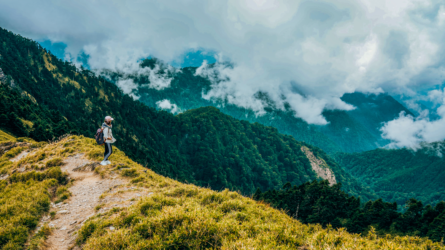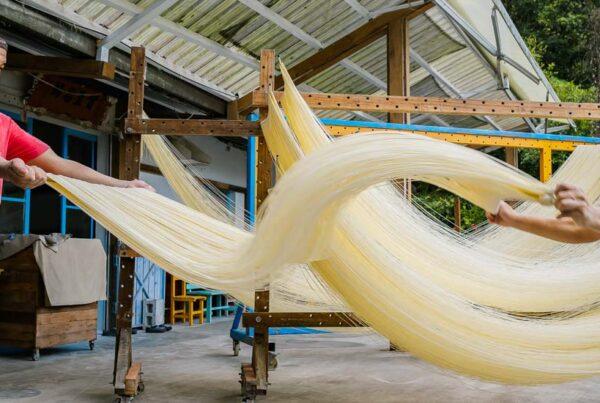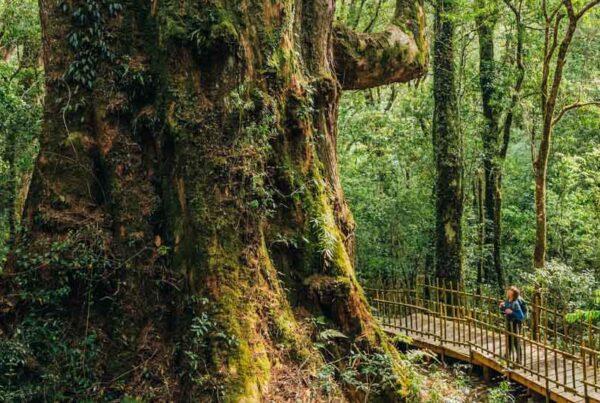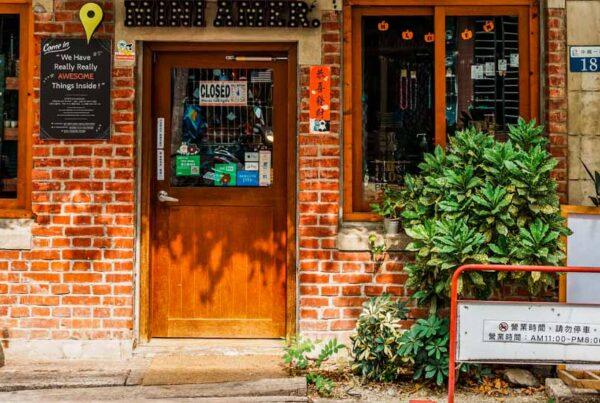Red Maple Leaves and Much More
TEXT / OWAIN MCKIMM
PHOTOS / SHOUYA SONG
Though one of Taiwan’s lesser-visited national forest recreation areas – particularly compared with tourist favorites like Alishan and Taipingshan – Aowanda is certainly no less lovely nor less abundant in its ecological offerings than its more popular counterparts.
Situated deep in the center of the island, at the western edge of Taiwan’s Central Mountain Range, Aowanda is at its most splendid between late fall and early spring, when the vast forest of maple, Formosan sweet gum, beech, and oak turns from green to russet and the blooming cherry trees daub the deep red swathes of autumn foliage with vibrant bursts of white, puce, and pink. And while it may be at its aesthetic height during the winter months, Aowanda has plenty to merit a visit in other seasons, too. Its size (almost 3,000ha), topography (a series of densely forested terraces and valleys that range between 1,100m and 2,600m above sea level), and location at the confluence of six different rivers ensure a wide range of biodiversity that includes hundreds of species of birds, butterflies, fireflies, and mountain mammals. This fecundity of wildlife, which made the area a prime hunting ground for members of Taiwan’s indigenous Atayal, Bunun, and Seediq tribes in the not-too-distant past, today makes Aowanda a prime location for birdwatchers and nature lovers.

Central Area
Entry to the recreation area (open daily 8am~5pm) costs NT$200 (with concessions for weekday entry, children, students, and the elderly), and the roughly 5km worth of trails can be comfortably explored over the course of a long afternoon – though a whole day could be spent here making a thorough survey of all the park’s points of interest.
A short walk from the slightly barebones Visitor Center – where you can pick up a trail map –you’ll find the Nature Education Center, which has excellent information in both English and Chinese about the flora and fauna that call the park home. Beyond the education center is the Cherry Garden Trail, awash in pastel hues in the winter months and verdant with pea-green foliage the rest of the year, overlooking a grassy meadow that would look quite at home in the musical drama film The Sound of Music if it weren’t for the jadeite-hue backdrop of the forested river gorge standing in for Alpine peaks.
Nearby, tucked into a shady glade is the Ecological Pond, which creates a similarly European-character illusion, resembling – even down to the Japanese-style footbridge that spans the pond – a scene from Monet’s Water Lilies series. From April to June, however, as evening falls the pond relinquishes its air of tranquility to the thrumming of mating frogs and the flashing bioluminescence of courting fireflies.




Eastern Trails
Walking in the direction of the park’s eastern reaches, you’ll first need to descend the Strongman’s Slope – a steep series of wooden steps that takes you from the upper river terrace down 100m to the alluvial plain below. From here you can follow the Maple Forest Walk adjacent to the riverbed, with sweeping views of the rising river valley, or the Bird-watching Trail through the dense inner forest, where you’ll be able to spot members of some of Aowanda’s 120-plus bird species, including the endemic Formosan blue magpie, also known as the “long-tailed mountain lady” in Chinese, and the Taiwan barbet, identifiable by its varicolored feathers and distinctive warble.

Along these trails, encounters with members of some of Aowanda’s 209 butterfly species, which dine on the forest’s many beech and mulberry mistletoe trees, and Taiwanese macaques, which shuffle through the canopy and seem to have as much fun observing you as you do them, are near certainties. Both trails will eventually lead you to the Bird-watching Platform, where you are gifted with an extraordinary view of Aowanda’s main arboreal attraction – the Pure Chinese Sweet Gum Forest.

Located at the confluence of the North River and South River as they become the Wanda River, this gathering of sweet gum specimens (brilliantly scarlet come winter) juts out into the riverbed of this newly formed waterway like the prow of a great ship, bravely pushing into the silt deposited on the plain by successive typhoons. On the terrace above the sweet gum forest lies the park’s easternmost point – the Pine Tree Zone, a forest of Taiwan red pines where the floor is blanketed each year with copper-colored pine needles.

To reach the Pine Tree Zone, visitors must first cross the imposing Aowanda Suspension Bridge, which spans the 180m expanse across the gorge. Built to replace a bridge destroyed in 2007 by Typhoon Sepat, the Aowanda Suspension Bridge is certainly not for those fearful of heights – the 90m drop to the riverbed below being enough to make even the calmest of heads spin. Nonetheless, those who do brave the crossing will be amply rewarded with some truly spectacular views of the North River valley as the waterway sweeps down to meet the South River, as well as an eagle’s eye view of the aforementioned sweet gum forest.


Food
After retracing your steps to the center of the recreation area, a hearty lunch can be taken at the Red Resort Village Restaurant, located in a rustic clapboard building, which serves the kind of classic Taiwanese fare typically found in local rechao or “hot fry” restaurants – braised pork belly with pickled vegetables, sautéed greens and mushrooms, deep-fried stream fish, braised tofu, chicken fried with scallions, and other similarly moreish dishes. You can order a-la-carte or choose one of several set menus designed for groups of up of ten people. Prices range from NT$180 for a single-person light set meal to NT$3,000 for a ten-person set meal containing nine different dishes.



Western Trails
Shorter than the eastern trails, the paths in the western section of the recreation area take you first past the Retention Basin (built in the late 1950s, and recently reactivated to supply the nearby Wanta Hydro Power Plant with extra water in times of peak energy consumption). In the summer, Pacific swifts, swallows, and Asian house martins hunt water-dwelling bugs in the basin while performing effortless aerial acrobatics.

From the basin you can take a trail uphill to a series of picturesque waterfalls (most impressive during the flood season between April and September). The tallest of these, known as the Flying Waterfall, drops 48m and is said to be a potent source of anions – negatively charged particles produced by the friction between the falling water and the air that, according to some sources, have beneficial effects on mood and human health.

Accommodation
For those wanting to stay in the recreation area overnight, accommodation is available in one of the park’s two villas – the Red Resort Village and the Green Resort Village – or in one of several wooden cabins set back amongst the maple and cherry blossom trees in the park’s central area. Rooms are simple, but pleasantly rustic, and staying in the park after hours will allow you to experience the area’s crepuscular and nocturnal wildlife (particularly desirable during the firefly season).

Rates range from NT$1,500 per night for a weekday stay in a two-person room at the Red Resort Village to NT$6,400 per night for a weekend stay in a six-person wooden cabin. Rooms can be booked online at awdonline.forest.gov.tw (Chinese).
Alternatively, plenty of accommodation options can be found in the Qingjing Farm area, about an hour’s drive to the north, or in Puli Township, about an hour’s drive to the west.
Getting There
If self-driving, Aowanda is roughly 3.5 hours from Taipei City, and less than 2 hours from central Taichung City. Take Freeway 3 to Taichung, then Freeway 6 eastwards to Puli. There, transfer onto Provincial Highway 14 (towards Qingjing Farm). After approximately 30km, turn right onto Da’an Road (Nantou Road 83). After passing the large Wanda Reservoir on your left, turn left as Da’an Road merges into Gaoping Road, and then follow the road to the park’s toll booth.
Public transport: Between October 1 and March 31 each year, the Nantou Bus Company runs a weekend shuttle-bus service to Aowanda from the Taichung High Speed Rail (HSR) Station, with stops at the Taichung Railway Station and the Puli Bus Station. Tickets can be booked by phone up to two weeks in advance by calling (049) 298-4031, ext. 23. For detailed information, visit www.ntbus.com.tw/bs-tour.html (Chinese).

Also read:
QINGJING FARM and HEHUANSHAN
SUN-LINK-SEA — Forests, Flowers, and Waterfalls
Scenic Attractions in Central Taiwan’s NANTOU County

About the author
















